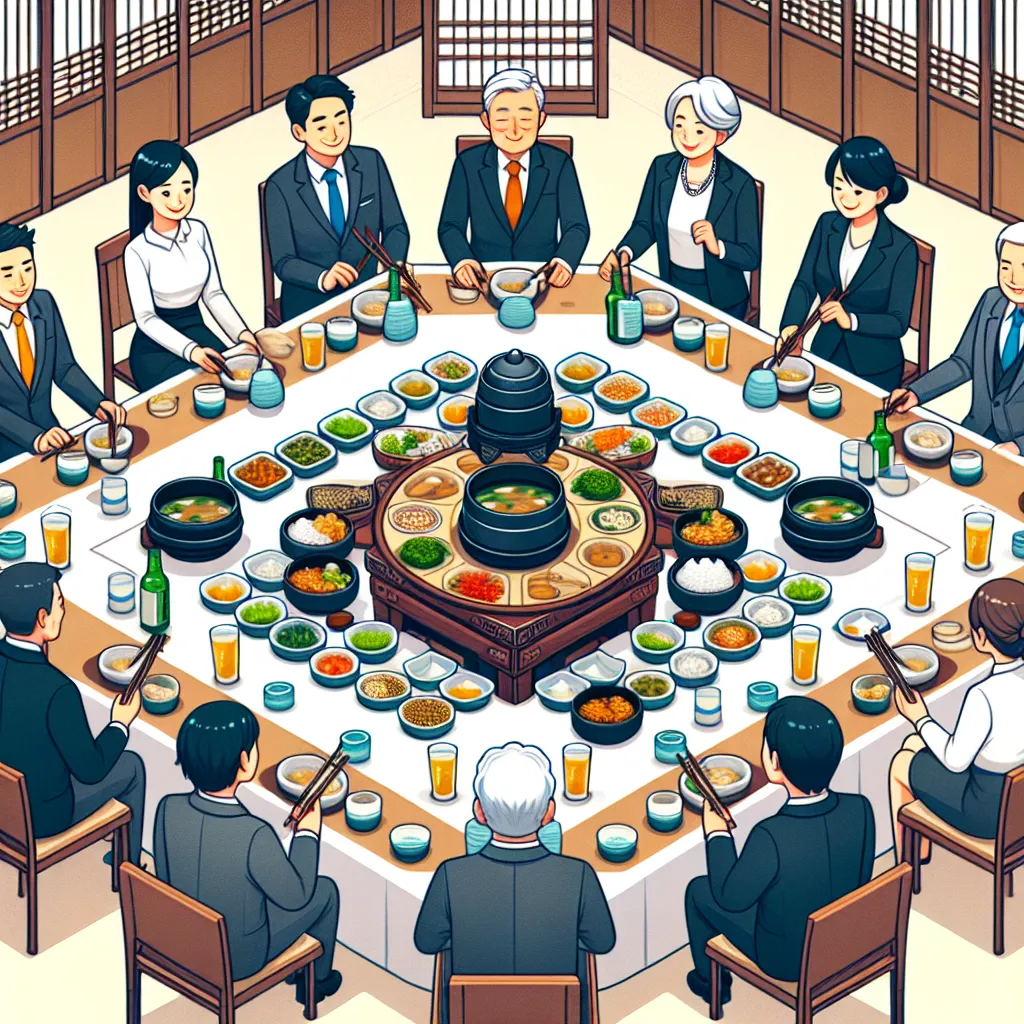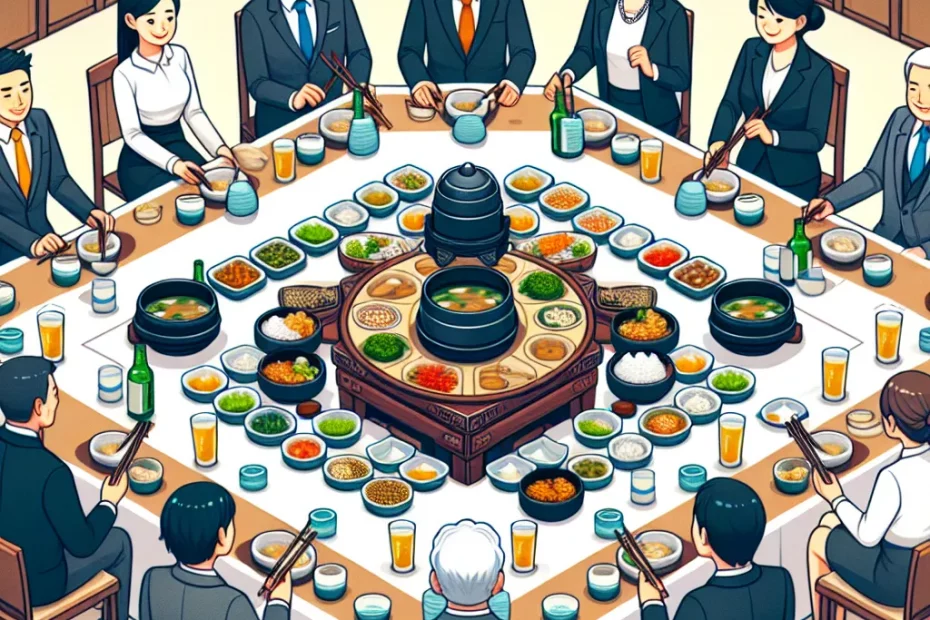Welcome to the world of Korean business dining etiquette! Company dinners in Korea are not just about the food; they are a reflection of respect, hierarchy, and camaraderie. As you navigate through the intricate customs of Korean dining, understanding the seating arrangement is crucial. Proper use of chopsticks and utensils showcases your respect for the culture. Drinking etiquette and toasting customs add a layer of warmth to the dining experience. And of course, respecting seniority and business hierarchy is key to building strong relationships. Let’s delve into these aspects together and uncover the nuances of Korean business dining etiquette.

Understanding the Seating Arrangement
Welcome to the world of Korean business dining etiquette! When it comes to company dinners in Korea, understanding the seating arrangement is crucial for making a good impression and showing respect to your colleagues and superiors.
The Significance of Seating Hierarchy
In Korean culture, seating hierarchy plays a significant role in determining the dynamics of the meal. The most important person or the host is usually seated at the center of the table, with the second most important person sitting next to them. The seating arrangement is often based on the individual’s rank, age, or position within the company.
It’s common to see a round table at business dinners in Korea, as it promotes a sense of equality among the diners. The host will typically sit facing the door, a position that holds significance as it allows them to oversee the entire gathering and welcome guests as they arrive.
Etiquette for Guests
As a guest, it’s essential to wait for your host to indicate where you should sit. Once directed, remember to take your seat graciously and avoid moving to a different seat unless asked to do so. This demonstrates your understanding of the hierarchy and respect for the host’s decisions.
If you find yourself unsure about where to sit, observe how others are positioning themselves and follow suit. When in doubt, it’s always best to ask for guidance rather than assuming a seat that may disrupt the seating protocol.
Remember, the seating arrangement at a Korean business dinner is more than just a physical layout; it reflects the social structure and values of the group. By showing attentiveness to these details, you can navigate the dinner with ease and leave a positive impression on your hosts and colleagues. Enjoy the meal and the company!
Proper Use of Chopsticks and Utensils
Chopsticks Etiquette:
Placement: When not in use, place your chopsticks on the chopstick rest or across your rice bowl. Avoid sticking them upright in your food, as this resembles a funeral ritual.
Gripping: Hold the top chopstick steady and use your thumb and index finger to move the bottom one. Practice the proper grip to pick up food effortlessly.
Passing Food: It is considered polite to use the end of your chopsticks that you haven’t touched with your mouth to pick up food from communal dishes.
Chopstick Taboos: Never point with your chopsticks, spear food, or pass food directly from your chopsticks to someone else’s chopsticks.
Utensils Protocol:
Spoon Usage: Hold the spoon in your dominant hand and use it for soups, stews, and rice. Do not use your spoon to eat rice directly from the bowl; instead, scoop small portions onto your spoon.
Fork and Knife: In formal settings, forks and knives may be provided for certain dishes. Use the fork in your left hand and the knife in your right hand, cutting food one piece at a time.
Napkin Placement: Place your napkin on your lap upon sitting down. Use it to dab your mouth, but avoid wiping your face or blowing your nose at the table.
Toast Tradition: When toasting, hold your glass with your right hand and support it with your left hand underneath. Make eye contact and clink glasses gently to show respect.
By mastering the proper use of chopsticks and utensils, you’ll not only showcase your respect for Korean dining customs but also enhance your dining experience with colleagues and clients. Remember, practice makes perfect, so don’t be afraid to embrace these etiquettes with confidence!
Drinking Etiquette and Toasting Customs
Welcome to the world of Korean business dining etiquette! When it comes to company dinners in Korea, understanding the drinking etiquette and toasting customs is crucial for building strong relationships with your Korean counterparts.
Drinking Together in Korean Culture
In Korean culture, drinking together is not just about enjoying alcohol; it’s a way to bond, show respect, and build camaraderie. So, when you find yourself at a company dinner in Korea, here are some tips to navigate the drinking etiquette and toasting customs like a pro:
🍶 Pouring Drinks: In Korea, it is customary for the youngest or most junior person at the table to pour drinks for others. When pouring soju or beer, hold the bottle with two hands as a sign of respect.
🍻 Accepting Drinks: When someone offers you a drink, receive it with both hands as a gesture of politeness. It’s also a good practice to turn your head slightly to the side when receiving a drink.
🥂 Toasting: Toasting plays a significant role in Korean business dinners. The most senior person or the host usually initiates the first toast. When clinking glasses, make sure your glass is lower than the other person’s glass as a sign of respect.
🍷 Drinking Pace: Koreans often engage in “Kanpai,” which means bottoms up! It’s common to finish your drink in one shot after a toast. However, if you prefer not to drink alcohol, you can politely decline by touching your glass with your fingers and offering a slight bow.
🎉 Multiple Rounds: Korean business dinners typically involve multiple rounds of toasts. Pace yourself and be mindful of your alcohol consumption to maintain professionalism throughout the evening.
Remember, mastering the drinking etiquette and toasting customs in Korean business culture can leave a lasting impression on your colleagues and business partners. So, raise your glass, enjoy the company, and cheers to successful business relationships in Korea!
Respecting Seniority and Business Hierarchy
When it comes to Korean business dining etiquette, respecting seniority and understanding the business hierarchy are crucial aspects to keep in mind. In Korean corporate culture, age and rank play a significant role in determining the dynamics of a business dinner. It is essential to show proper respect to senior members of the company and adhere to the established hierarchy to ensure a successful and harmonious dining experience.
The Significance of Seniority
In Korean business culture, the concept of seniority holds great importance. Older individuals are typically viewed with reverence and are considered to have more experience and wisdom. Therefore, when attending a company dinner, it is customary to defer to senior members in terms of seating arrangements, ordering food, and initiating conversations. Showing deference to senior colleagues not only demonstrates respect but also helps maintain a sense of order and hierarchy within the group.
Understanding Business Hierarchy
Understanding the business hierarchy is also key to navigating a Korean business dinner successfully. In Korean companies, there is a clear hierarchy based on rank and position. It is essential to be aware of the seniority of each individual present and to address them accordingly. Using appropriate titles and honorifics when speaking to senior members shows respect and acknowledges their authority within the company.
When engaging in conversation during a business dinner, it is important to be mindful of the topics discussed. Avoid controversial subjects or anything that may cause discomfort or offense to others. Instead, focus on light-hearted topics such as food, travel, or shared interests. By maintaining a positive and respectful attitude, you can contribute to a pleasant dining experience for everyone involved.
In addition to showing respect to senior members and understanding the business hierarchy, it is also essential to observe proper dining etiquette. This includes using chopsticks correctly, waiting for the eldest person to start eating before you begin, and not leaving the table until the most senior member has finished their meal. These small gestures demonstrate your understanding of Korean customs and show that you value the traditions and practices of your Korean colleagues.
Overall, by respecting seniority and understanding the business hierarchy, you can navigate Korean business dining with confidence and grace. Remember to show deference to senior members, be mindful of the established hierarchy, and observe proper dining etiquette to ensure a successful and harmonious experience for all. 🍽️👔🇰🇷
When it comes to Korean business dining etiquette, understanding the seating arrangement, using chopsticks and utensils properly, respecting seniority, and following drinking etiquette are crucial. These practices not only show respect for your hosts but also demonstrate your professionalism and cultural awareness. By mastering these aspects, you can navigate company dinners with ease and leave a positive impression on your Korean counterparts. Remember, dining etiquette is not just about following rules but also about building relationships and showing appreciation for the culture. So, embrace these customs with an open mind and enjoy the experience of dining with your Korean business partners.
